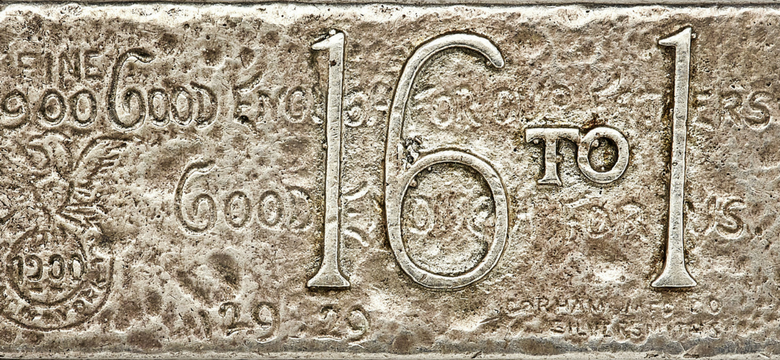Bryan dollars were struck during the 1896 and 1900 presidential campaigns by eastern silversmiths to promote the “free silver” agenda of Democratic candidate William Jennings Bryan. Today, each piece tells the story of the socio-economic climate of the last quarter of the 19th century in America.
At the heart of these two fiercely-fought campaigns was the raging debate of bimetallism or “free silver.” Republican William McKinley, who would win both elections over Bryan, believed the country should operate on the gold standard. Bryan was in favor of a bimetallic system, in which gold and silver coins together formed the basis of the American dollar.
From 1792 to 1873, the United States effectively operated on a bimetallic system: gold and silver bullion could be deposited at the Mint and converted into coins. The problem was that various factors continually influenced the relative values of the two metals. For instance, the discovery of gold in California in 1849 caused silver to become relatively scarce and thus more valuable, while the extraction of vast quantities of silver from the Comstock Lode in the late 1860s and early 1870s made it more plentiful than gold and therefore less valuable. This had significant effects on the coinage in circulation.
Additionally, the uncertainties of the Civil War, the issuance of different forms of paper money and the widespread production of minor copper and nickel coinage had the added effect of driving gold and silver out of circulation for years at a time.
Suffice it to say, things were complicated. Unfortunately, few politicians, Mint personnel or Treasury officials fully understood (or cared) how laws and economic policies affected the circulation of coins and currency or the effect they had on the American economy. What’s more is that many members of Congress were beholden to a variety of special interests, including nickel and silver barons, further skewing their beliefs.
The Argument for Free Silver
Led by the Comptroller of the Treasury, John Jay Knox, Congress passed the Coinage Act of 1873. Among other things, the law abolished the standard silver dollar, required gold to be deposited in exchange for silver subsidiary coins, and effectively created a gold standard.
That same year, the American economy experienced a crushing depression known as the Panic of 1873. Sparked by the failure of Jay Cooke & Co. and a subsequent run on banks, the country spiraled into a downturn that resulted in increased unemployment, falling wages, and deflation.
Farmers, among the hardest hit by the economic crisis, saw their access to credit dry up and their debts balloon. Many believed that a bimetallic system would increase the money supply and relieve much of the country of its crippling financial burdens.
Similar events in 1893 brought the issue of free silver to the fore once again. Three years later, bimetallism dominated the campaign of 1896 and formed the basis of William Jennings Bryan’s platform. He famously proclaimed in his speech at the Democratic National Convention, “you shall not crucify mankind upon a cross of gold.”
Bryan Dollars
Farran Zerbe, one of the preeminent numismatists (and numismatic promoters) of the early 20th century, wrote an article in the July 1926 issue of The Numismatist, the monthly periodical put out by the American Numismatic Association. Zerbe’s article, entitled “Bryan Money: Tokens of the Presidential Campaigns of 1896 and 1900 — Comparative and Satirical,” enumerated 141 medals and tokens struck by various makers in a host of different compositions.
He classified these into two groups: comparative and satirical. The former he described as “produced by silversmiths in the East. They are struck in coin silver, in proportion and with dignified inscription to show the true size and ratio at the then market price of silver with the advocated free coinage of that metal.” Zerbe added, “The satirical class comprises pieces of numerous variety in size and material with derisive or humorous inscription or design. Most all are casts; a few were struck. Type metal, or some composition of lead, and aluminum were the most generally used materials, with: iron, copper, tin and cardboard contributing a few varieties.”
Zerbe was not the only one to study and categorize Bryan dollars. Harold Hibler and Charles Kappen included them in their “So-Called Dollars” reference, and Fred Schornstein wrote an entire treatise aptly titled Bryan Money.
Our Central States Signature Offerings
Heritage Auctions is delighted to present one of the finest collections of Bryan dollars ever assembled in our April 25-29, 2018 CSNS US Coins Auction. The collection comprises 14 lots of comparative Bryan money and a rare silver ingot. Many of these pieces were made by some of the most renowned silversmiths of the late 19th and early 20th centuries, including Tiffany, Gorham and Jaccard.
Perhaps what’s most exciting about this group is that the 14 Bryan dollars once formed the basis of Farran Zerbe’s personal collection and the ingot was likely used as the for the plate image in his 1926 article. The coins were later integrated into the Mr. and Mrs. Alfred J. Ostheimer Collection, which is best known for its silver dollars but which also included an extensive set of so-called dollars that totaled more than 1,000 coins. Dealer and collector W. David Perkins purchased the lot from Mrs. Ostheimer in the early 2000s. They have since been acquired by the present consignor. The 14 Bryan dollars are certified by NGC with the Zerbe-Ostheimer-Perkins pedigree noted on the insert.
The upcoming sale will give collectors interested in this series the opportunity to acquire many important rarities and finest-known examples that have never been offered publicly.
Visit our U.S. Coins department to view upcoming auctions and to browse our auction archives.
Written by: Jacob Lipson
